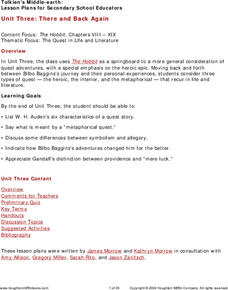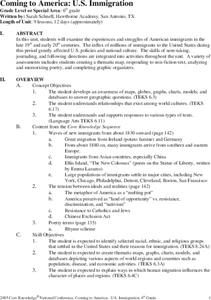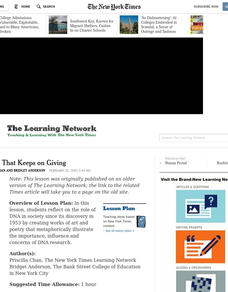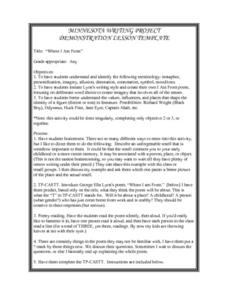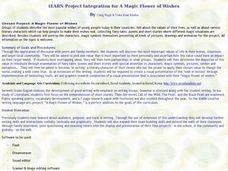Curated OER
Pinhole Photo Narratives
Students create original pieces of poetry and use this as a basis for a photography series using "pin-hole camera" techniques. This high school activity is cross-curricular in scope.
Curated OER
A Courtin' We Will Go
Young scholars investigate dialect in poetry as an indication of a people's culture in literature. They write a poem about dating in this era.
Curated OER
Analysis of Character in a Short Story
Ninth graders examine a character from the short story, John Steinbeck's, "Flight." students respond to questions about the story and illustrate the character's journey.
Ereading Worksheets
Figurative Language for Edgar Allen Poe
Are your classes weary of dreary worksheets? Are the learners nearly napping? Thrill them, fill them with delight with an interactive worksheet that asks them to identify the figurative language Edgar Allen Poe uses to add horror and...
Curated OER
Writing Organizers
Eight graphic organizers to choose from? That's right! Each of these organizers relates to writing or reading. From narrowing a writing topic, to responding to literature, to planning a writing project, you'll find many purposes for...
Curated OER
Poetic Analysis
Students write a poetic analysis on a poem by Carl Sandburg. They take their previous knowledge of poetic devices and apply them to a piece of writing that displays their knowledge on a specific poem. They explain what they know about a...
Curated OER
The Hobbit
Young scholars list W.H Auden's six characteristics of a quest story. They say what is meant by a "metaphorical quest." Pupils discuss some differences between symbolism and allegory. Students indicate how Bilbo Baggins's adventures...
Curated OER
Rock & Roll through Literary Terms: An Upbeat Lyrical Adventure
Learners participate in a variety of activities surrounding Rock & Roll music, lyrics, drama and visual art and how they all help demonstrate examples of literary terms. They use Rock & Roll as an effective aid to stimulate their...
Curated OER
A Walk Through the Past: A Grave Undertaking
Learners explore how historians construct a story out of fragments of the past; a discussion of nineteenth century poetry and art leads students to connect art and literature to their place in time.
Curated OER
Coming to America: U.S. Immigration
Students study immigration in the late 19th and early 20th century. In this immigration lesson plan, students participate in activities including creating maps, responding to non fiction text, memorizing and analyzing poetry, and...
Curated OER
The Gift That Keeps on Giving
Students reflect on the role of DNA in society since its discovery in 1953 by creating works of art and poetry that metaphorically illustrate the importance, influence and concerns of DNA research.
Curated OER
Zen and the Work of Frank Lloyd Wright
High schoolers experience Zen philosophies reflected in artwork, poetry, and architecture. Students will explore these connections and expand the discussion to include a professional author of their choice.
Curated OER
The Relationship Between Zen And Haiku Aesthetics
High schoolers examine the principles of Haiku as they relate to idealss found in Zen Buddhism in this High School instructional activity. The instructional activity concludes with the creation of individual haikus by each student.
Curated OER
Cartoons for the Classroom: Sarcasm, Irony, and Satire
Satire, sarcasm, or irony? Editorial cartoons have long been the tool artists use to express their opinions about politics and politicians. Kevin "Kai" Kallaugher's four-panel cartoon offers readers an opportunity to examine how he uses...
Curated OER
Original Line or Familiar Find?
Young scholars examine a primary source document from 1684 that includes many of the same lines found in Romeo's speech to Juliet from Shakespeare's Romeo and Juliet. Students compare the texts and discuss authorship during the sixteenth...
Curated OER
Where I Am From
Students study selected poetry to gain an understanding of influences on values and personal identity. They explore language terms such as personification, imagery metaphors and allusion. After reading a poem and discussing it,...
Curated OER
Out of the Dust: Figurative Language
Young scholars find examples of figurative language in "First Rain" in Out of the Dust. In this Out of the Dust lesson, students takes notes on various type of figurative language and identify examples of each type in the poem.
Curated OER
Identifying Figurative Language
In this figurative language worksheet, students identify figurative language in the sentences and explain their answers. Students complete 10 problems.
Curated OER
Ode to a Nightingale
Students read poems about Tuberculosis by John Keats. Using the poems, they identify similies, metaphors, personification and imagery. In groups, they make connections about the author's outlook on life and how his disease impacted his...
Curated OER
The Witch of Goingsnake
Learners identify figurative language in a proverb and write an interpretation of the proverb prior to reading The Witch of Goingsnake. In this The Witch of Goingsnake lesson plan, students read a native American proverb and determine...
Curated OER
Literature Collaborative Learning Project
Students, in groups, from Israel study literature in English. They practice communicating in the language and to write poems. They create a website in English describing aspects of their country.
Curated OER
Figurative Language 2
Learners read nursery rhymes and advertisements to identify examples of figurative language. As a class, students discuss the use of figurative language and its effectiveness in advertising, children's books, rhymes, poetry, etc. ...
Curated OER
New York State Testing Program English Language Arts Book 1--Grade 7 (2006)
In this New York State Testing Program English Language Arts worksheet, students read several passages and two poems and answer reading comprehension questions. Students then write an essay response to one of the passages.
Curated OER
A Magic Flower of Wishes
Students discuss which values are most important to them and their families. They read poetry and fairy tales to find a story that has the same value they find most important. They create a presentation and share it with the class.






